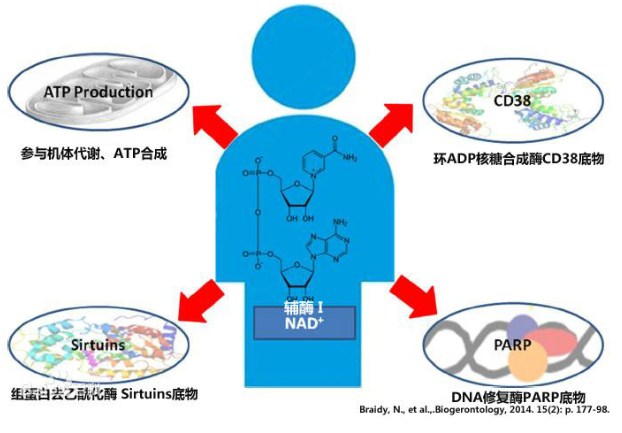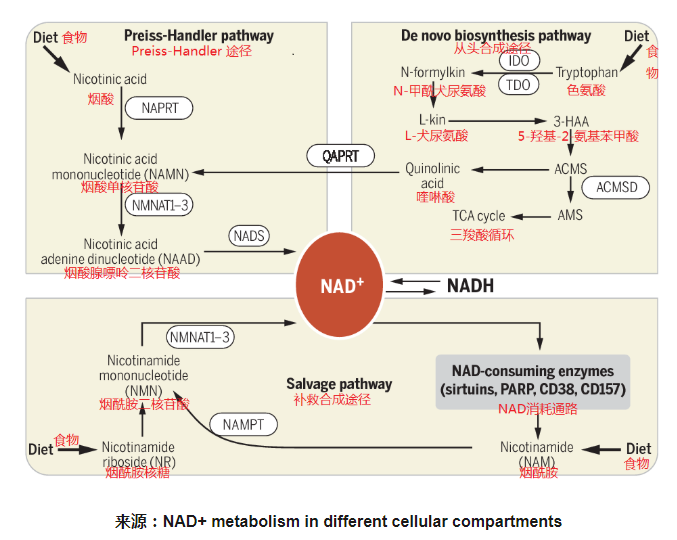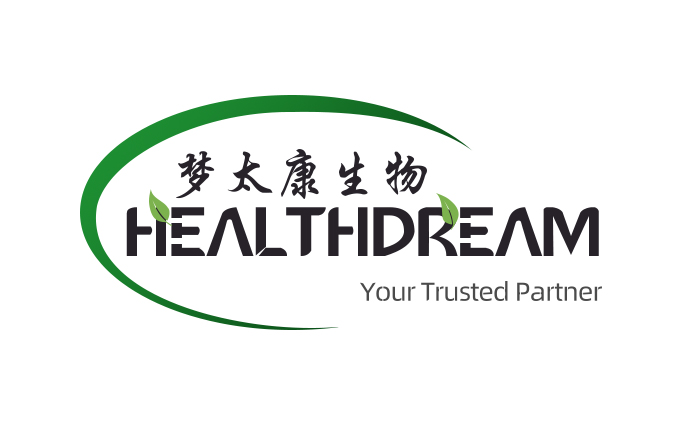Healthdream | Nicotinamide mononucleotide(NMN)-longevity factor
Views : 1422
Author : Melissa
Update time : 2019-09-20 15:19:16
Healthdream | Nicotinamide mononucleotide(NMN)-longevity factor
NMN is the world's first revolutionary breakthrough that can antioxidation and prolong life through rigorous scientific verification. Its anti-aging effect was first discovered by Harvard University's David Sinclair Laboratory in 2014 and is an important longevity factor.
NMN is the world's first revolutionary breakthrough that can antioxidation and prolong life through rigorous scientific verification. Its anti-aging effect was first discovered by Harvard University's David Sinclair Laboratory in 2014 and is an important longevity factor.

In the human body, NMN is a precursor of NAD+, and its function is reflected by NAD+.
NAD+, also known as coenzyme I, is a full name of nicotinamide adenine dinucleotide, also known as nicotinic acid diphosphate, which participates in thousands of reactions in each cell. NAD+ is an important coenzyme of the Krebs cycle, promoting the metabolism of sugars, fats and amino acids, and participating in the synthesis of energy; NAD+ is the only substrate for coenzyme I depleting enzymes (the only substrate for the DNA repair enzyme PARP, the only long-lived protein Sirtuins). Substrate, the sole substrate for the ring ADP ribose synthase CD38/157).
NAD+ is involved in various metabolisms of the human body and is a key coenzyme. Metabolism will cause problems without NAD+. If the elderly lack NAD+, they are prone to various diseases. By supplementing NAD+ additionally, they can fully resist aging. The figure below shows the metabolic pathway of NAD+. NAD+ has three metabolic pathways in the body, and the four species can eventually be converted into NAD+.

A. Preiss-Handler approach
Founded by Preiss and Hsndler from 1957 to 1958, it was named the Preiss-Handler route. This pathway starts from niacin and is converted to nicotinic acid mononucleotide by niacin phosphoribosyltransferase (NAPRT), which is converted to nicotinic acid adenine dinucleotide by NMNATI1~3 enzyme, and then Catalyzed into NAD+.
B. De novo synthesis pathway
This pathway is also called the kynurenine pathway. Starting from the tryptophan ingested in food, it is sequentially passed through N-formyl kynurenine, L-kynurenine, 5-hydroxy-2-aminobenzoic acid, ACMS to become quinolinic acid, then quinolinic acid. Enter the Preiss-Handler path. The IDO and TDO pathways for the conversion of tryptophan to N-formyl kynurenine are a limiting step in the de novo synthesis pathway, and ACMS can also enter the tricarboxylic acid cycle.
C. Remediation synthesis pathway
NAD+ becomes nicotinamide after three consumption pathways (sirtuins, PARPs, and the cADPR), and then becomes NMN after NAMPT catalysis. NMN also completes the cycle by catalytic conversion of NMNAT1~3 enzyme to NAD+.
The content of NAD+ is balanced under these three independent pathways. It can be seen from the above figure that the salvage synthesis pathway is the main source of human NAD+. The salvage synthesis pathway accounts for 85% of the NAD+ production. From the perspective of supplementing NAD+, there are four types of substances that can be substituted: niacin, nicotinamide, tryptophan, NR/NMN. Niacin is vitamin B3, niacin and nicotinamide are also called vitamin PP. From the perspective of Preiss-Handler and de novo synthesis, how to supplement niacin and tryptophan, the combination of niacin (NA) and GPR109A It causes severe flushing of the patient, and excessive intake of tryptophan and niacinamide may also have side effects.
In summary, NMN is the most ideal way to supplement NAD+, which is the longevity factor.
A. Preiss-Handler approach
Founded by Preiss and Hsndler from 1957 to 1958, it was named the Preiss-Handler route. This pathway starts from niacin and is converted to nicotinic acid mononucleotide by niacin phosphoribosyltransferase (NAPRT), which is converted to nicotinic acid adenine dinucleotide by NMNATI1~3 enzyme, and then Catalyzed into NAD+.
B. De novo synthesis pathway
This pathway is also called the kynurenine pathway. Starting from the tryptophan ingested in food, it is sequentially passed through N-formyl kynurenine, L-kynurenine, 5-hydroxy-2-aminobenzoic acid, ACMS to become quinolinic acid, then quinolinic acid. Enter the Preiss-Handler path. The IDO and TDO pathways for the conversion of tryptophan to N-formyl kynurenine are a limiting step in the de novo synthesis pathway, and ACMS can also enter the tricarboxylic acid cycle.
C. Remediation synthesis pathway
NAD+ becomes nicotinamide after three consumption pathways (sirtuins, PARPs, and the cADPR), and then becomes NMN after NAMPT catalysis. NMN also completes the cycle by catalytic conversion of NMNAT1~3 enzyme to NAD+.
The content of NAD+ is balanced under these three independent pathways. It can be seen from the above figure that the salvage synthesis pathway is the main source of human NAD+. The salvage synthesis pathway accounts for 85% of the NAD+ production. From the perspective of supplementing NAD+, there are four types of substances that can be substituted: niacin, nicotinamide, tryptophan, NR/NMN. Niacin is vitamin B3, niacin and nicotinamide are also called vitamin PP. From the perspective of Preiss-Handler and de novo synthesis, how to supplement niacin and tryptophan, the combination of niacin (NA) and GPR109A It causes severe flushing of the patient, and excessive intake of tryptophan and niacinamide may also have side effects.
In summary, NMN is the most ideal way to supplement NAD+, which is the longevity factor.
A. Preiss-Handler approach
Founded by Preiss and Hsndler from 1957 to 1958, it was named the Preiss-Handler route. This pathway starts from niacin and is converted to nicotinic acid mononucleotide by niacin phosphoribosyltransferase (NAPRT), which is converted to nicotinic acid adenine dinucleotide by NMNATI1~3 enzyme, and then Catalyzed into NAD+.
B. De novo synthesis pathway
This pathway is also called the kynurenine pathway. Starting from the tryptophan ingested in food, it is sequentially passed through N-formyl kynurenine, L-kynurenine, 5-hydroxy-2-aminobenzoic acid, ACMS to become quinolinic acid, then quinolinic acid. Enter the Preiss-Handler path. The IDO and TDO pathways for the conversion of tryptophan to N-formyl kynurenine are a limiting step in the de novo synthesis pathway, and ACMS can also enter the tricarboxylic acid cycle.
C. Remediation synthesis pathway
NAD+ becomes nicotinamide after three consumption pathways (sirtuins, PARPs, and the cADPR), and then becomes NMN after NAMPT catalysis. NMN also completes the cycle by catalytic conversion of NMNAT1~3 enzyme to NAD+.
The content of NAD+ is balanced under these three independent pathways. It can be seen from the above figure that the salvage synthesis pathway is the main source of human NAD+. The salvage synthesis pathway accounts for 85% of the NAD+ production. From the perspective of supplementing NAD+, there are four types of substances that can be substituted: niacin, nicotinamide, tryptophan, NR/NMN. Niacin is vitamin B3, niacin and nicotinamide are also called vitamin PP. From the perspective of Preiss-Handler and de novo synthesis, how to supplement niacin and tryptophan, the combination of niacin (NA) and GPR109A It causes severe flushing of the patient, and excessive intake of tryptophan and niacinamide may also have side effects.
In summary, NMN is the most ideal way to supplement NAD+, which is the longevity factor.

